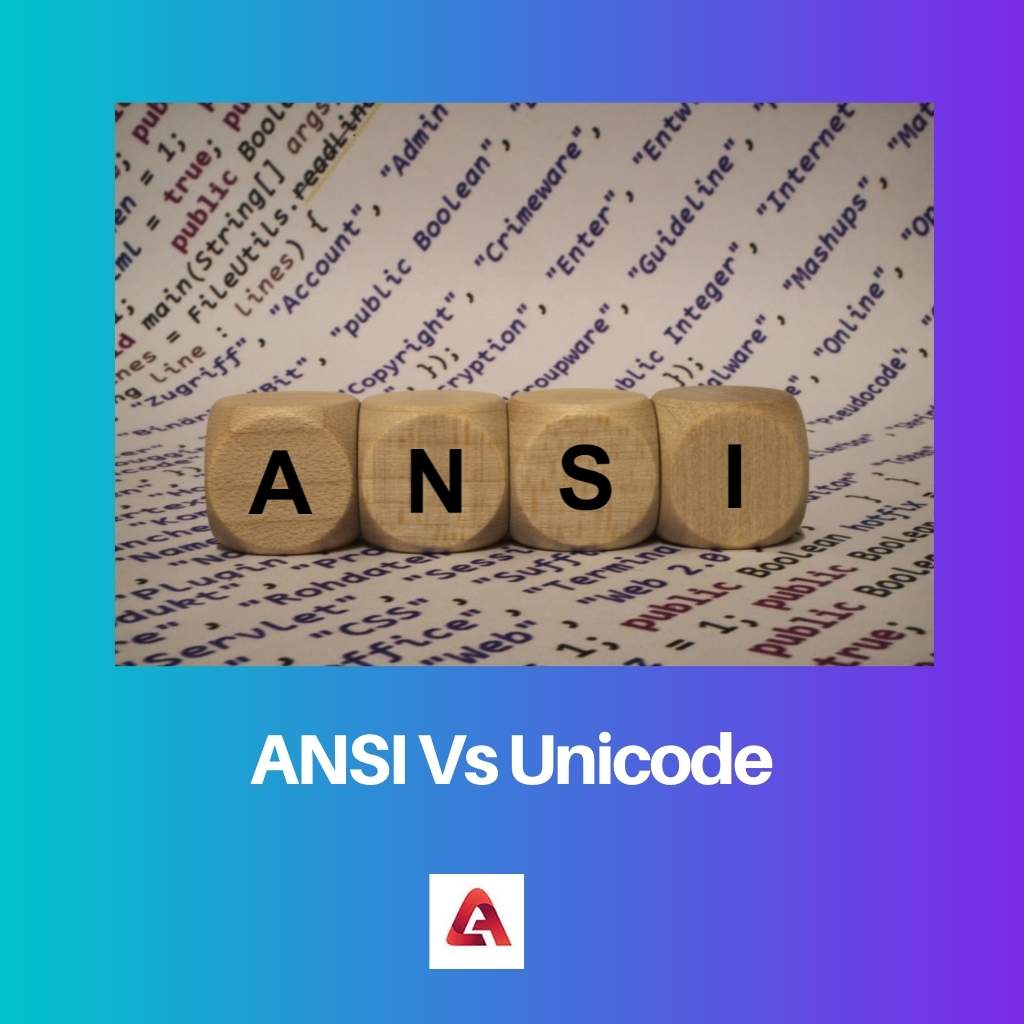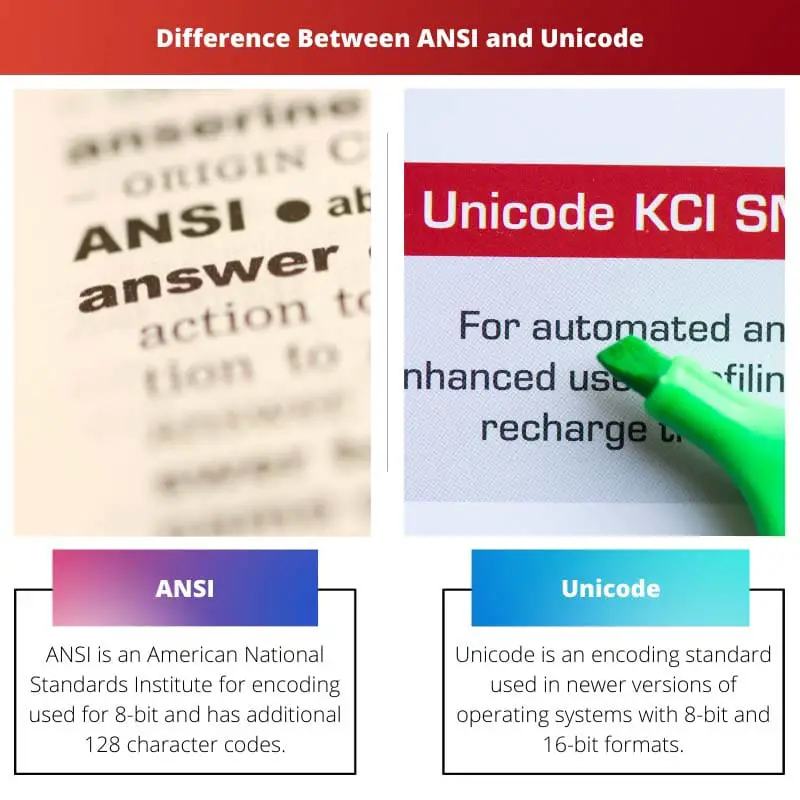ANSI and Unicode are encoding standards used across the world by writers and common users. ANSI is an older encoding version and is used in operating systems like Windows 95/ 98 and many older systems.
Unicode is a newer version of encoding used in the current day operating systems.
Key Takeaways
- ANSI is a character encoding standard used in North America, while Unicode is used worldwide.
- ANSI is limited to 256 characters, while Unicode can represent over 1 million characters.
- ANSI can only represent characters in one language at a time, while Unicode can simultaneously represent multiple languages and scripts.
ANSI Vs Unicode
ANSI is a character encoding standard used in computing. It is a single-byte encoding scheme that can represent up to 256 characters. Unicode is a multi-byte encoding scheme that can represent a much larger set of characters from different languages and scripts, including emojis and symbols.

ANSI is a standard code page used for encoding in an operating system like Windows, which is a much older version of encoding. It is considered to be an extension of ASCII, which is 7-bit, while ANSI is 8-bit and has additional 128 character codes in it.
The acronym of ANSI is the American National Standards Institute.
Unicode is a character encoding system that is of fixed length, unlike ANSI. Unicode is a newer version of the encoding standard used in present-day operating systems.
The encoding character scheme is incorporated with all languages widely used across the world. It has two encoding forms used, 8-bit and 16-bit, based on the encoding system.
Comparison Table
| Parameters of Comparison | ANSI | Unicode |
|---|---|---|
| Definition | ANSI is an American National Standards Institute for encoding used for 8-bit and has additional 128 character codes. | Unicode is an encoding standard used in newer versions of operating systems with 8-bit and 16-bit formats. |
| Speed of operation | ANSI programs are slower in encoding standards in operating systems like Windows | Unicode is much faster in encoding characters in operating systems like Windows, Linux. |
| Width | ANSI has a fixed width while encoding standard characters. | Unicode has both fixed and variable width while encoding various characters. |
| System operation | ANSI is an older version of encoding and hence can be used in older versions of operating systems as well as is incorporated in the newer ones. | Unicode is a newer version of the encoding that is used in the newer versions of operating systems and hence cannot be used in the older versions. |
| Languages used for encoding | ANSI is used in different pages for different languages across the operating systems. | Unicode uses only one platform for performing all the character encodings. |
What is ANSI?
ANSI is an American National Standard Standard Institute used for encoding characters that have the 8-bit character set with 127 additional characters when compared to ASCII.
ANSI is an extended version of ASCI that has 7-bit, which is formulated into an 8-bit character set encoding system. They have different character set languages for different sets.
ANSI is used in operating systems like Windows 95/98, which are older versions. It is used in both older and newer encoding standards.
It uses different platforms for different languages, which forms a limitation of the ANSI encoding system. For the English encoding page, Western European Latin is used.
ANSI uses only 8 bits to represent every code, which is why it is limited for its accommodating feature. It has a fixed width and has 127 additional characters that account for about 256 combinations of characters.
It has a mechanism of converting ANSI to Unicode and hence can be operated in newer and older versions of operating systems like Windows.
ANSI programs are slower in their mechanism. It is a Microsoft-related format for character conversion and encoding. It helps in formatting and making unreadable formats of files into readable ones using the encoding mechanism.
It has over 128 language variations present in the encoding process.
What is Unicode?
Unicode is a character encoding that is used in present-day operating systems like Windows. It has two types of versions available: 8-bit character encoding and 16-bit character encoding.
They have a single platform for encoding in all the languages available. It is updated and revised in the edition called The Unicode Standard.
Unicode has both fixed and variable widths. It is the current encoding standard that is widely used. It is faster in its encoding standard platforms, unlike ANSI. The default encoding is the 16-bit encoding system.
It has a hexadecimal point of code used. It has 65000 code elements that are capable of encoding in all languages over the world.
The Unicode extension is used in encoding more than one million characters.
The extended and supplementary character is encoded in the extension mechanism pair of high and low surrogate characters that vary in the number of bits involved in the mechanism.
The high surrogate character lies between a bounded parameter between U+D800 and U+DBFF.
Unicode is capable of converting Non-Unicode databases into Unicode formats. There are various data types available in Unicode encoding systems. It uses 32 bits as its maximum limit for coding points in characters.
The latest version of encoding has 159 scripts of coding characters. It covers almost all scripts in the encoding process.

Main Differences Between ANSI And Unicode
- ANSI is an American National Standards Institute for encoding in both older and newer versions of operating systems, whereas Unicode is an encoding standard used in newer versions of operating systems.
- ANSI is much slower in speed but good in its encoding process, whereas Unicode is much faster than the latter.
- ANSI is used in 8-bit character form with around 256 characters in its encoding process, whereas Unicode is in two forms and the default one would be 32-bits and has more than one million characters in its coding.
- ANSI uses different platforms for encoding different languages, whereas Unicode uses only one platform for encoding all the languages across the world.
- ANSI has a fixed width in encoding characters of point of code, whereas Unicode has a fixed width and variable width in encoding the point of characters.


This article provides a comprehensive and in-depth comparison between ANSI and Unicode encoding standards, highlighting the key takeaways and differences. It’s a great resource for understanding the importance and functionality of these two important encoding schemes.
I couldn’t agree more, Fred. The article covers all the essential aspects of ANSI and Unicode and is an informative read for anyone interested in programming and computing.
The detailed descriptions of ANSI and Unicode encoding, along with their functions and limitations, are very enlightening. The article delivers a balanced and objective perspective on these encoding standards.
I couldn’t agree more, Scott. The comparison of ANSI and Unicode is presented with clarity and precision, providing readers with a thorough comprehension of these important encoding schemes.
An informative and well-researched article. It’s a fantastic resource for understanding the nuances of ANSI and Unicode encoding, especially for those in the field of computer science and programming.
While the article thoroughly explains the technical aspects of ANSI and Unicode encoding, it overlooks the potential security implications and vulnerabilities associated with these standards.
Your point is valid, Dave. A discussion on the security considerations and risks of using ANSI and Unicode encoding in various applications would enhance the overall depth of the article.
I concur, Dave. Exploring the security landscape and potential threats related to encoding standards is crucial in providing a comprehensive understanding of these technologies.
The article effectively explains the encoding standards of ANSI and Unicode, making it accessible to all readers. The comparison between the two is presented clearly, and the real-world applications of each standard are well articulated.
Well said, Isabelle. This article is a valuable resource for understanding the historical context, functionalities, and impact of these encoding standards in the digital landscape.
While I appreciate the detailed comparison of ANSI and Unicode encoding, the article lacks a critical analysis of the practical implications and performance differences between the two standards.
I share your sentiments, Owalsh. It would be beneficial to include more insights on the real-world impact and practical considerations of implementing ANSI and Unicode in software development.
The article provides an insightful overview of ANSI and Unicode encoding standards, offering a balanced comparison. However, it would be valuable to explore the evolving landscape of encoding in modern technology environments.
A thought-provoking perspective, Sally. The article sets a strong foundation but could benefit from an exploration of future trends and developments in encoding technologies.
I agree, Sally. It’s essential to delve into the adaptations and advancements in encoding standards, considering the dynamic nature of technology and digital platforms.
I found the comparison table particularly helpful in understanding the differences between ANSI and Unicode encoding. The clear explanations and examples make it easy to comprehend the technical details.
Absolutely, Paula. The detailed breakdown of differences is very insightful and will be beneficial for developers and tech enthusiasts.
I appreciate the comprehensive information provided in this article. It’s refreshing to see a well-researched and educational piece that sheds light on complex technical subjects.